The resurgence of rhythm action games in 2015 was a thrilling moment for dedicated fans. Two titans of the genre, Guitar Hero and Rock Band, made their comeback, each promising a unique and immersive musical journey. For PlayStation 4 gamers eager to shred on a plastic guitar, the choice between Guitar Hero Live and Rock Band 4 was a crucial one. Both titles offered the allure of becoming a guitar hero, but which game truly hit the right notes for the PS4 platform?
Having spent considerable time with both games on the PlayStation 4, this in-depth comparison will serve as your ultimate guide. We’ll dissect each game across critical categories to help you decide which rhythm game deserves a place in your PS4 library. Let’s dive into the head-to-head battle and determine which game strikes the chords of victory.
Round 1: Backwards Compatibility on PS4
For many returning fans, the question of instrument compatibility is paramount. Do those dusty plastic guitars from previous console generations still have a purpose? A game that allows you to dust off your old gear is undoubtedly a win.
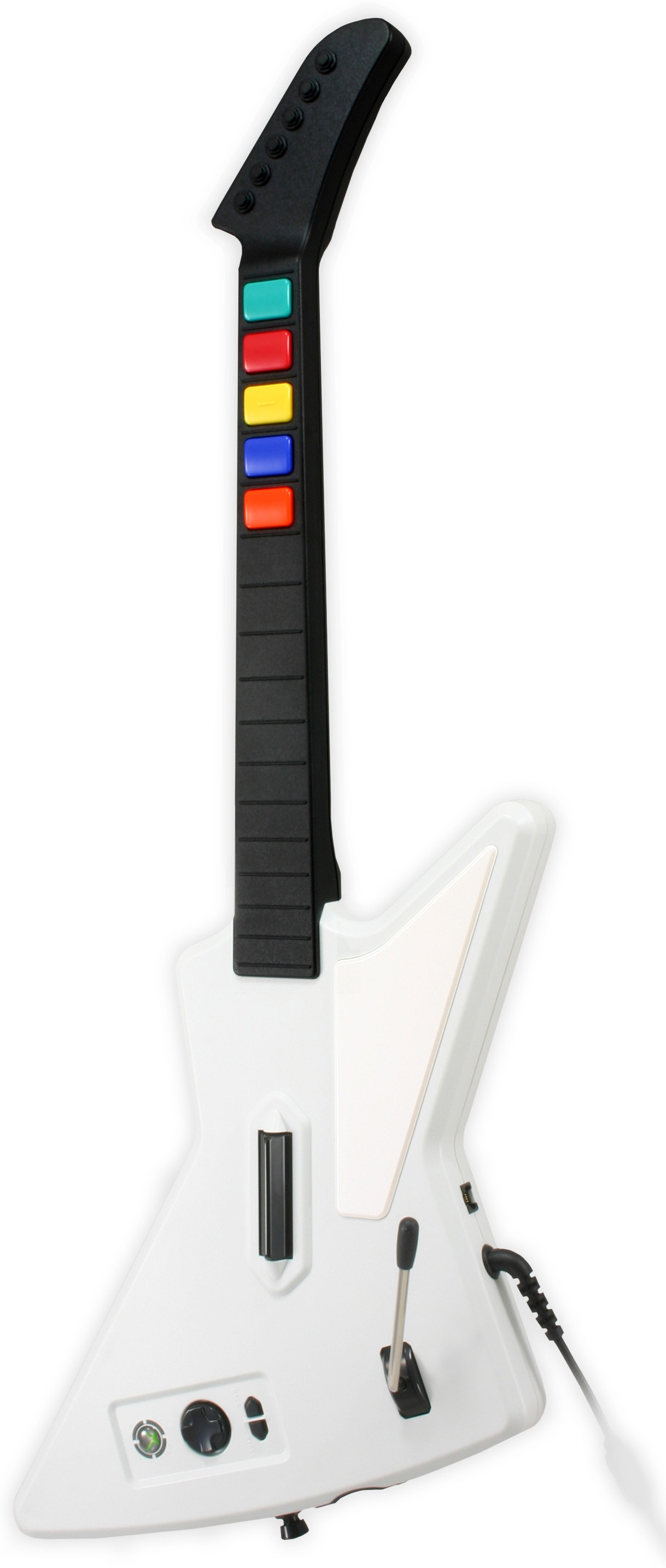 Classic Guitar Hero Controller
Classic Guitar Hero Controller
Alt text: A well-loved Guitar Hero 2 controller, symbolizing the legacy of plastic instrument games and the question of backwards compatibility for new PS4 rhythm games.
Rock Band 4 embraced the past, boasting extensive backwards compatibility with legacy Rock Band and Guitar Hero peripherals on PS4. Harmonix worked to ensure that your investment in previous generation instruments wasn’t in vain. For the most part, this worked seamlessly. Wireless guitar controllers from Guitar Hero 3 and Rock Band on PS3 generally connected without issue to the PS4 version of Rock Band 4.
However, the compatibility wasn’t absolute. Wired controllers, due to Sony’s device authentication protocols, were not supported. This meant that trusty wired guitars, like the Guitar Hero II Xplorer, were unfortunately rendered obsolete. While a niche case, it was a point of frustration for some dedicated players with specific setups.
On the other hand, Guitar Hero Live took a different approach. Revolutionizing the guitar gameplay with a brand-new six-button layout (two rows of three), Guitar Hero Live made a clean break from the past. This innovative design, while exciting, came at the cost of complete incompatibility with all previous guitar controllers. The five-color button system of older guitars simply wouldn’t translate to the new mechanics.
Winner – Rock Band 4 (for PS4 players with legacy instruments)
Round 2: Guitar Gameplay Experience on PlayStation 4
While Rock Band broadened the rhythm game experience with drums, vocals, and bass, the guitar remains the iconic instrument for many. How do Guitar Hero Live and Rock Band 4 cater to the core guitar-playing experience on PS4?
Rock Band 4 on PS4 stayed true to its roots, retaining the familiar five-color lane highway system. Veterans of the Guitar Hero and Rock Band franchises could instantly pick up the guitar and feel at home. The core gameplay remained largely unchanged, focusing on note-for-note accuracy and building streaks.
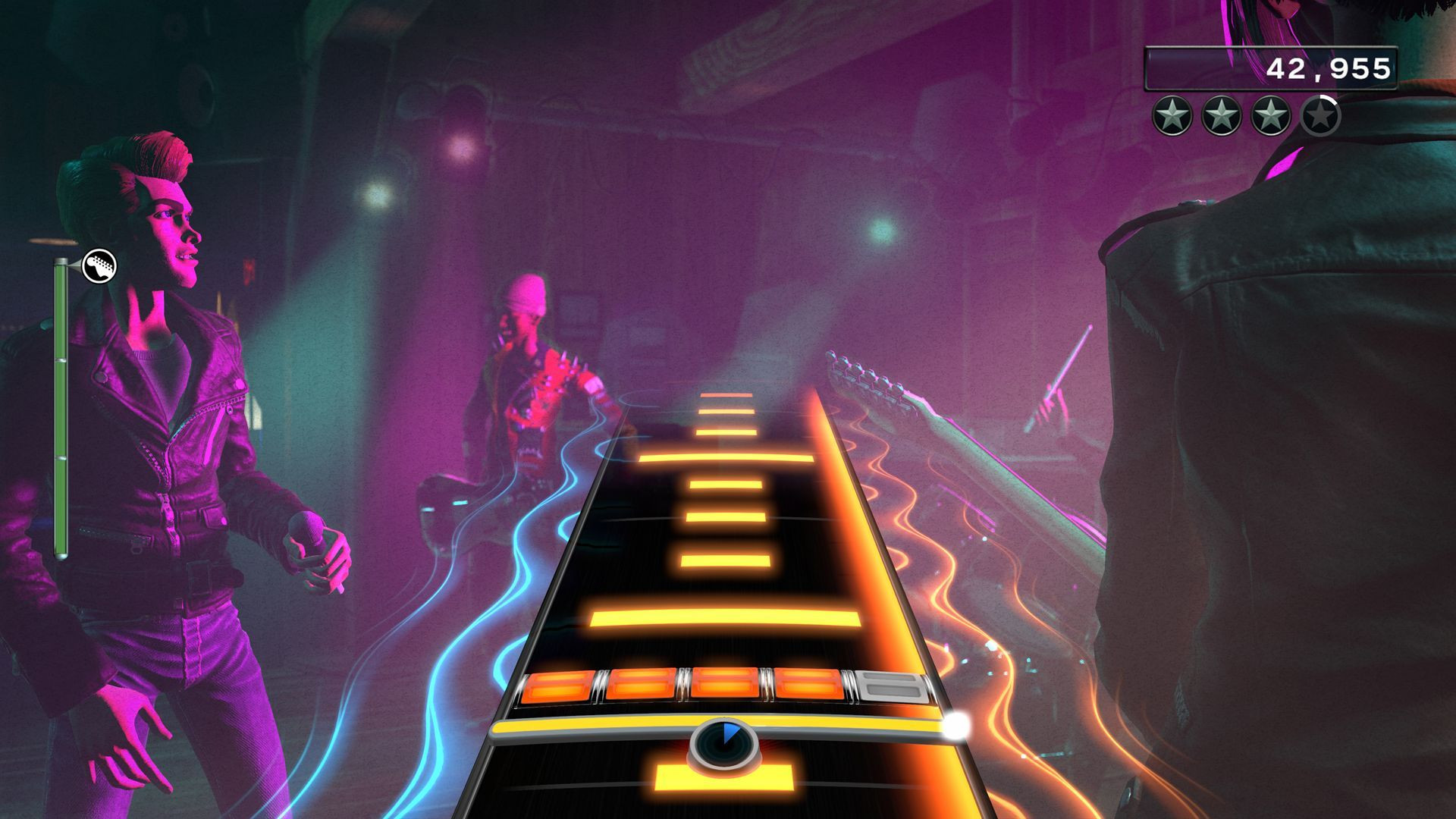 Rock Band 4 Gameplay on PS4
Rock Band 4 Gameplay on PS4
Alt text: Rock Band 4 gameplay on PlayStation 4 showcasing the classic five-lane note highway during a guitar solo section.
A notable addition to Rock Band 4 was the freestyle guitar solo sections. These sections offered a degree of improvisation, allowing players to strum freely and have the game interpret their input into a coherent solo. While a novel idea, the execution sometimes fell flat, with generated solos occasionally sounding disjointed. Fortunately, these freestyle sections could be toggled off for purists. Overall, Rock Band 4 provided a comfortable, evolutionary guitar experience on PS4.
Guitar Hero Live on PS4, however, opted for a revolutionary approach. The game discarded the five-color system entirely, introducing a brand new guitar controller with two rows of three buttons. This innovative six-button layout aimed to emulate the feel of playing a real guitar, introducing chord shapes and finger positioning more akin to actual guitar playing.
This new system created a steeper learning curve initially, but offered a more rewarding and engaging experience in the long run. Higher difficulty levels demanded complex chord shapes spanning both rows of buttons, creating a satisfying sense of accomplishment as muscle memory developed. Freestyle Games, the developers, previously acclaimed for DJ Hero, demonstrated their expertise in crafting innovative peripherals.
After an initial adjustment period, Guitar Hero Live‘s guitar gameplay on PS4 proved to be a significant step forward, offering a fresh and more tactile experience compared to the established five-color standard.
Winner – Guitar Hero Live (for innovative and more guitar-like gameplay on PS4)
Round 3: Beyond Guitar: Instruments and Band Experience on PS4
The appeal of rhythm games extends beyond just guitar for many players. The ability to form a virtual band and play with friends across different instruments is a key part of the genre’s charm.
Rock Band 4 on PS4 remained committed to the full band experience. Drums, bass guitar, and vocals were all present and accounted for, maintaining the core band dynamic that defined the series. Again, most wireless legacy controllers for these instruments were compatible, allowing players to assemble a full band setup without completely replacing their gear.
Sadly, one instrument was notably absent: keyboards. Rock Band 4 dropped keyboard support, sidelining an instrument that had shown promise in Rock Band 3.
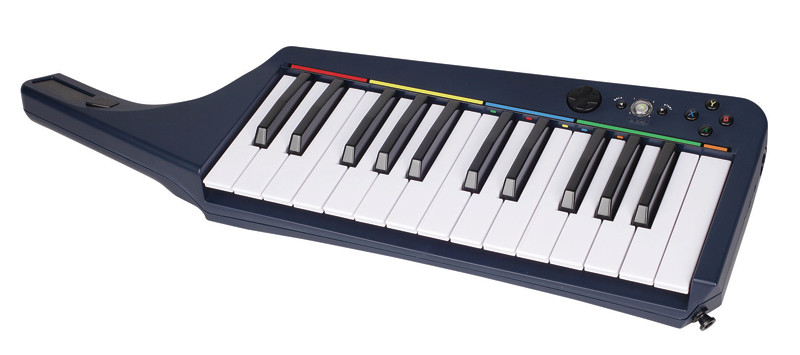 Rock Band 3 Keyboard Controller
Rock Band 3 Keyboard Controller
Alt text: A Rock Band 3 keyboard controller, representing the instrument support offered in previous games but absent in Rock Band 4 on PS4.
Guitar Hero Live on PS4, in contrast, doubled down on the guitar focus. It streamlined the experience to center solely on the lead guitar role. Drumming and bass guitar were completely absent. While vocals were an option, using either a compatible microphone or a companion app, they felt more like an afterthought. Guitar Hero Live was unequivocally focused on mastering the guitar, leaving other instruments behind.
Winner – Rock Band 4 (for offering the full band experience on PS4)
Round 4: Visual Design and Immersion on PlayStation 4
Visual presentation plays a significant role in immersing players in the rock star fantasy. Guitar Hero Live and Rock Band 4 adopted vastly different visual styles for the PS4.
Rock Band 4 on PS4 opted for an evolutionary approach to its visual style. It refined the established Rock Band aesthetic with increased detail, but maintained the familiar cartoonish character models and stage environments. The visual upgrade was subtle rather than dramatic.
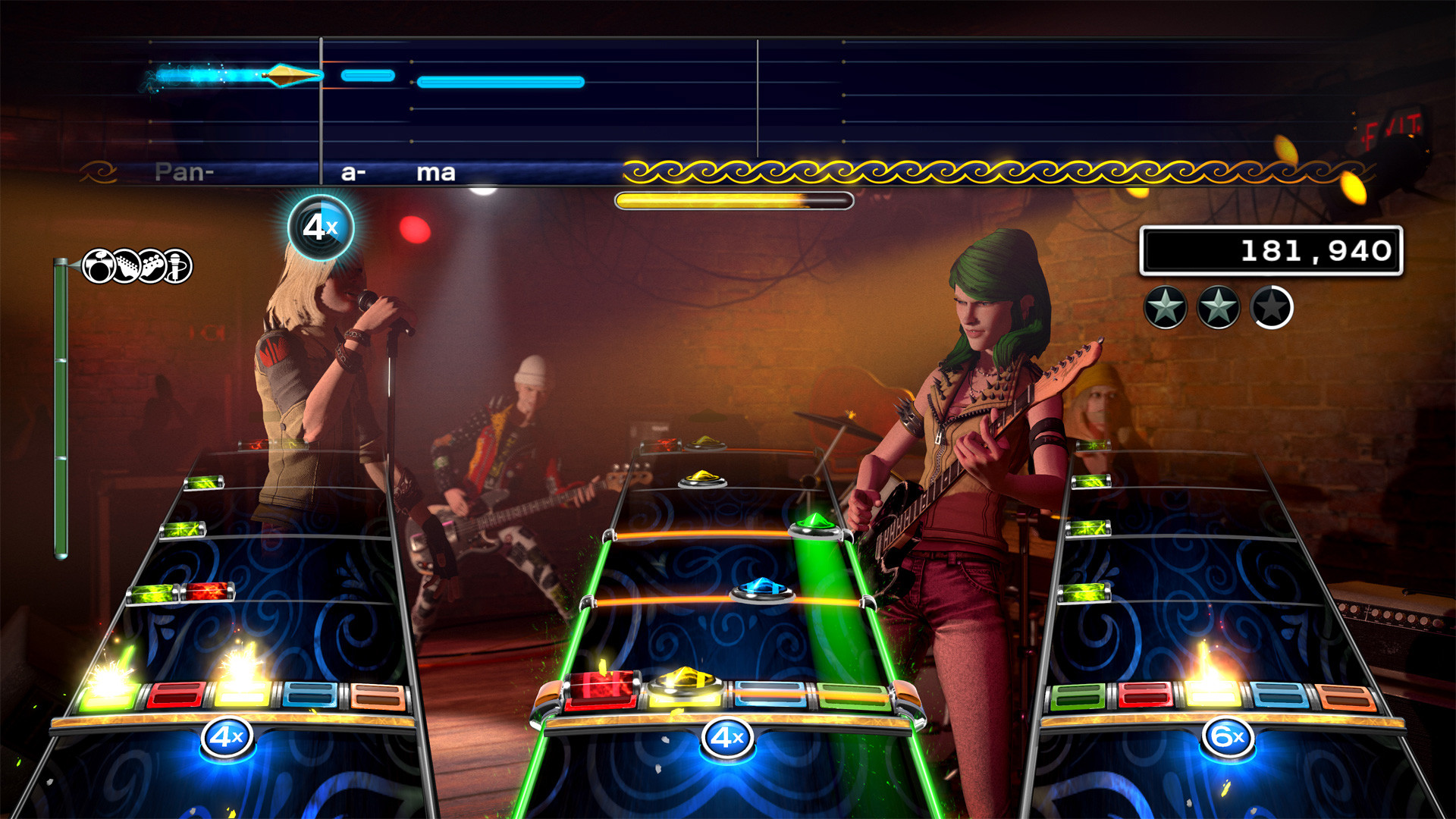 Rock Band 4 Visual Style on PS4
Rock Band 4 Visual Style on PS4
Alt text: Rock Band 4’s visual style on PlayStation 4, showcasing the familiar cartoonish graphics and stage presence characteristic of the series.
The familiar visual engine was designed to seamlessly integrate with a vast library of downloadable content, ensuring consistency across thousands of songs. Character animations and lip-syncing were designed to adapt to a wide range of musical styles.
Guitar Hero Live on PS4 took a radical departure, embracing full-motion video and a dual-mode structure. The game featured two distinct visual experiences: GHTV and GH Live.
GHTV mode presented a streaming music television channel concept. Players would play along to music videos, with the official videos playing in the background. This provided a dynamic and visually engaging way to discover new music and artists.
GH Live mode offered a first-person perspective of live concert performances. The game utilized pre-recorded videos of live bands, with the crowd and band member reactions dynamically changing based on player performance.
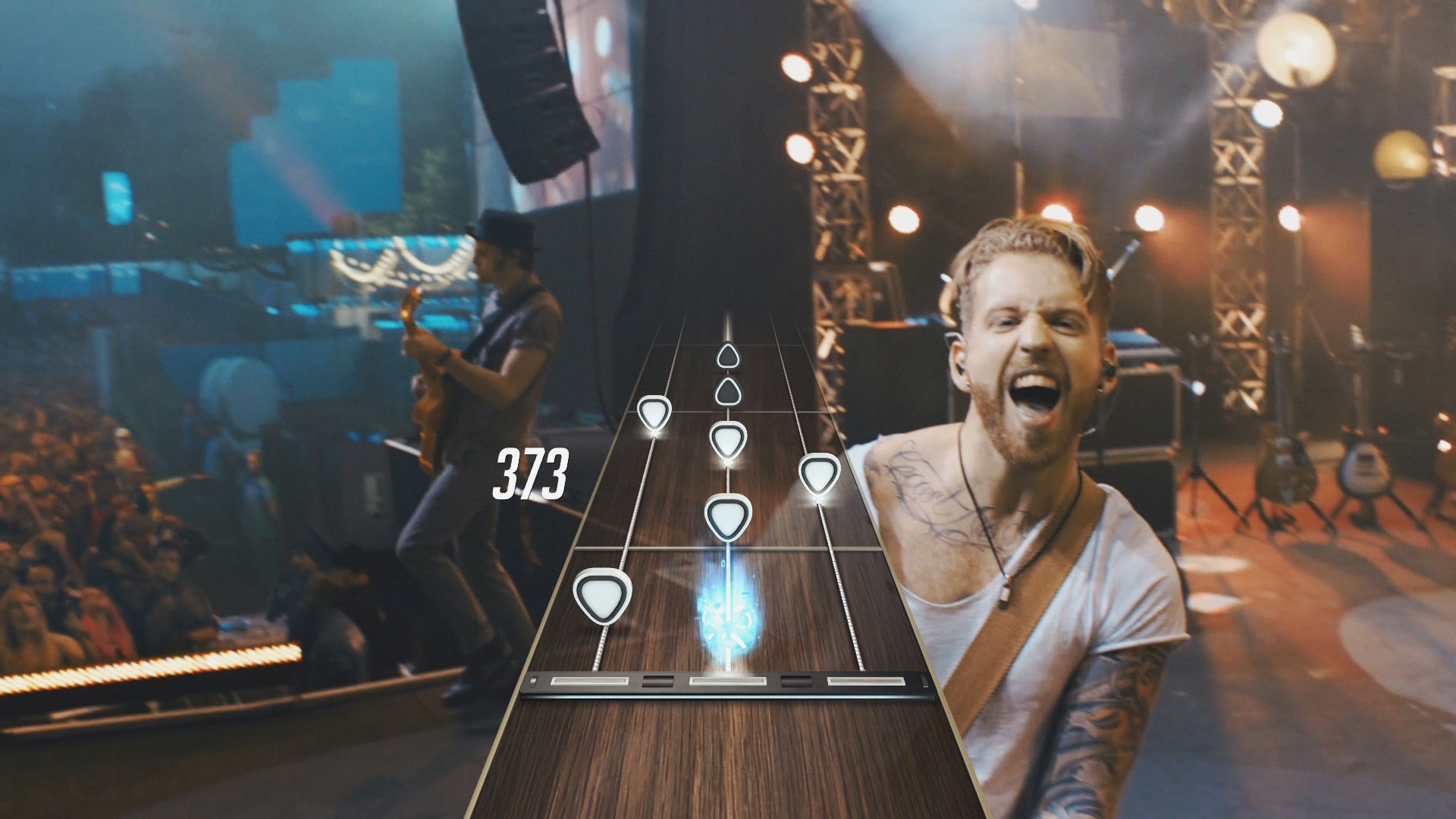 Guitar Hero Live First-Person Perspective on PS4
Guitar Hero Live First-Person Perspective on PS4
Alt text: Guitar Hero Live’s first-person live concert perspective on PlayStation 4, showing the immersive but sometimes artificial crowd and band visuals.
While technically impressive, the GH Live mode’s execution was divisive. The acting was often criticized as cheesy, and the hyper-realistic, flawless appearance of the band members and crowds struck some players as unrealistic and off-putting. Despite the intended immersion, it could feel artificial. However, the GHTV mode’s music video integration provided a unique and appealing visual element.
Winner – Guitar Hero Live (for GHTV mode’s music video integration, despite GH Live mode’s shortcomings on PS4)
Round 5: On-Disc and Free Content Libraries on PS4
The initial content offering is a crucial factor, especially for players hesitant to invest in downloadable content. How do Guitar Hero Live and Rock Band 4 compare in terms of their out-of-the-box song selections and free content options on PS4?
Rock Band 4 on PS4 launched with a respectable 65 on-disc songs, spanning a wide range of genres and eras, from classic rock to contemporary hits. While the on-disc library was fixed, Rock Band 4 offered occasional free songs through online updates, though these were infrequent. Expanding the song library primarily relied on purchasing downloadable content. Even importing songs from previous Rock Band games required a purchase.
Guitar Hero Live on PS4 offered a smaller on-disc selection of 42 songs for its GH Live mode. However, it compensated with the innovative GHTV mode, which launched with over 200 playable music videos accessible via streaming. This GHTV library was continuously expanded with free updates, adding over 90 songs in the initial months after launch.
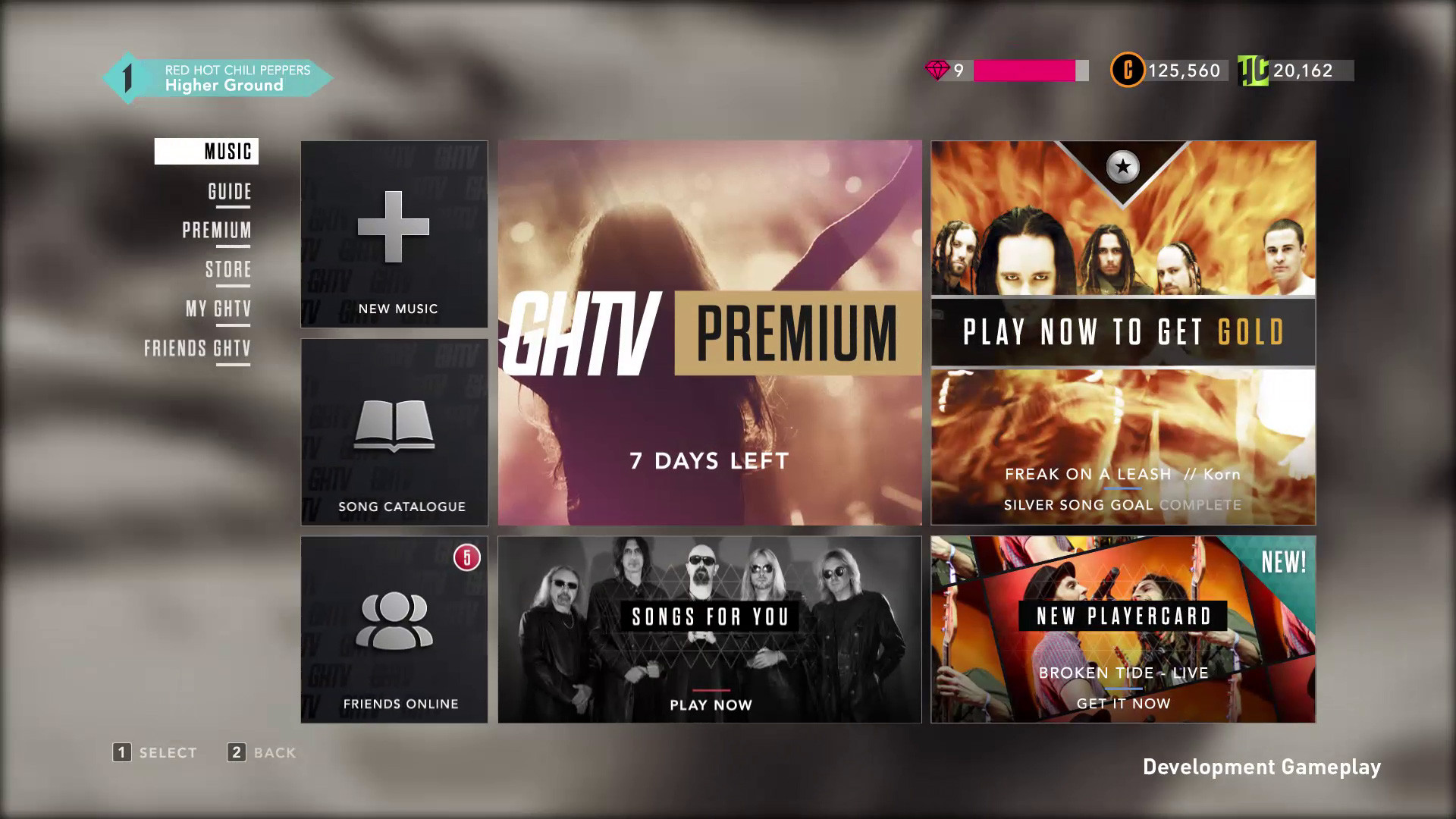 Guitar Hero Live GHTV Mode on PS4
Guitar Hero Live GHTV Mode on PS4
Alt text: Guitar Hero Live’s GHTV mode on PlayStation 4, highlighting the streaming music video channels and the vast library of playable songs available at no extra cost.
GHTV’s streaming nature meant songs were not always available on demand, but players could earn in-game currency to purchase “play tokens” allowing them to play specific songs at any time. This in-game currency could be earned through regular play, offering a path to access the extensive GHTV library without additional real-money purchases. Guitar Hero Live offered a significantly larger and growing library of free playable content compared to Rock Band 4 on PS4 at launch.
Winner – Guitar Hero Live (for significantly more free content via GHTV mode on PS4)
Round 6: Downloadable Content and Song Libraries on PS4
For players willing to invest in downloadable content (DLC), the depth and flexibility of the DLC ecosystem become crucial. How do Guitar Hero Live and Rock Band 4 cater to DLC enthusiasts on PS4?
Guitar Hero Live on PS4 presented a less appealing DLC proposition. While GHTV offered a vast library, players never truly owned the songs. Playing specific songs on demand required tokens, creating a recurring expense if players wanted to repeatedly play favorite tracks. Furthermore, the resource-intensive nature of the GH Live mode, with its full-motion video and bespoke performances, made adding new DLC songs to that mode impractical and unlikely. The 42 on-disc GH Live songs represented the finite extent of that mode’s library.
Rock Band 4 on PS4, conversely, excelled in downloadable content. Its engine was designed for easy DLC integration, and Harmonix leveraged its extensive back catalog. A vast majority of the Rock Band 3 DLC library was ported to Rock Band 4, resulting in a massive library of over 1500 songs available for purchase.
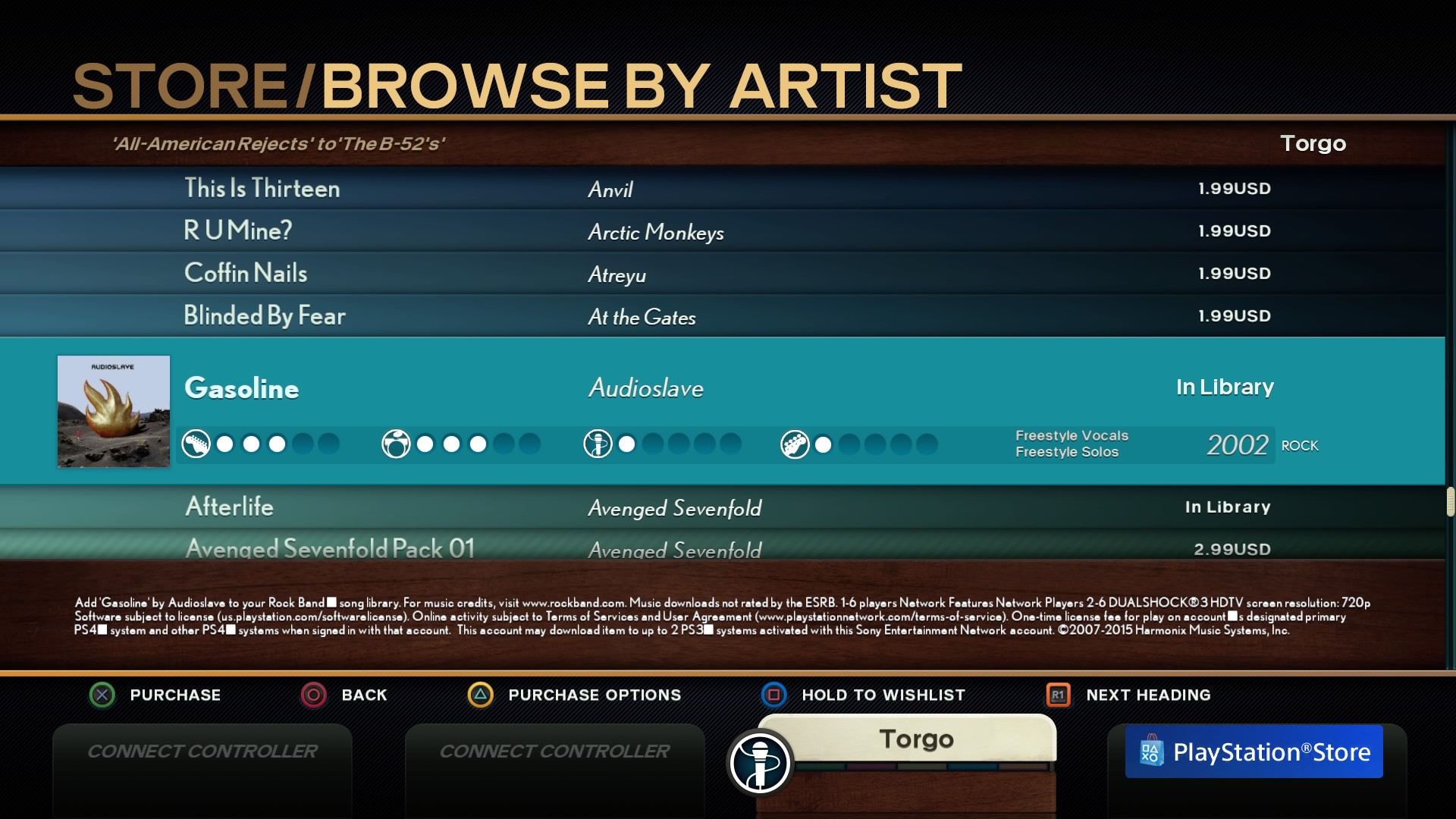 Rock Band 4 DLC Library on PS4
Rock Band 4 DLC Library on PS4
Alt text: Rock Band 4’s extensive DLC library on PlayStation 4, showcasing the availability of a vast catalog of songs for purchase and permanent ownership.
Crucially, purchasing Rock Band 4 DLC granted permanent ownership. Players could play their purchased songs as often as desired without further expenditure. For players invested in building a large and personalized music library, Rock Band 4 offered a far superior and more consumer-friendly DLC ecosystem on PS4.
Winner – Rock Band 4 (for a vast, permanently owned DLC library on PS4)
Round 7: Single-Player Experience and Progression on PS4
Rhythm games can be enjoyed solo or with friends. How do Guitar Hero Live and Rock Band 4 cater to the single-player gamer on PS4?
Guitar Hero Live on PS4 was clearly designed with single-player in mind. The focus on lead guitar, the first-person perspective in GH Live, and the absence of other instruments all pointed towards a solo-centric experience.
The GHTV mode featured a profile progression system, where players earned experience points and leveled up by playing songs. Leveling up unlocked customization items like note highways and profile icons, providing a sense of progression and reward for solo play. GHTV songs also featured specific challenges, adding replayability for solo gamers seeking to maximize their scores and completion.
Rock Band 4 on PS4 offered a less compelling single-player progression system. Its Career mode was relatively short compared to previous Rock Band iterations. Beyond Career mode, single players were primarily limited to Quick Play mode, selecting individual songs to play. Rock Band 4 lacked the persistent progression and unlockables that Guitar Hero Live offered for solo players on PS4.
Winner – Guitar Hero Live (for a more engaging single-player progression system on PS4)
Round 8: Local Multiplayer and Social Gaming on PS4
Plastic instrument games often shine brightest in local multiplayer, bringing friends and family together for musical fun. How do Guitar Hero Live and Rock Band 4 handle local multiplayer on PS4?
Guitar Hero Live on PS4 severely underdelivered in local multiplayer. It only supported a second guitar in GHTV mode, and even then, both players played the same guitar part, fostering competition rather than cooperation. This competitive, same-instrument multiplayer lacked the collaborative and social spirit that defines the genre for many. Guitar Hero Live‘s single-player focus came at the expense of a meaningful local multiplayer experience.
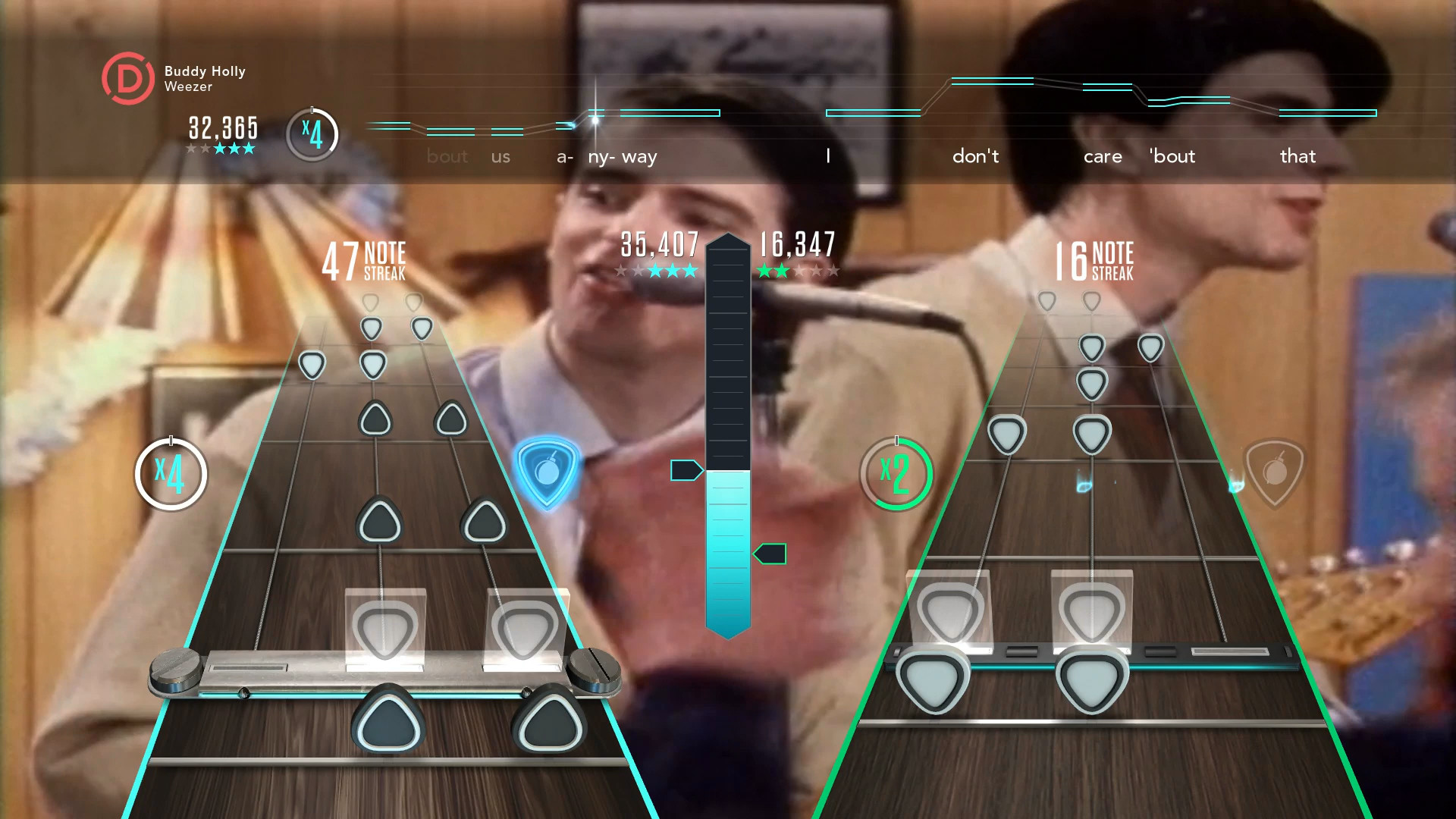 Guitar Hero Live Local Multiplayer on PS4
Guitar Hero Live Local Multiplayer on PS4
Alt text: Guitar Hero Live’s limited local multiplayer on PlayStation 4, highlighting the competitive same-instrument gameplay and lack of cooperative band experience.
Rock Band 4 on PS4, in contrast, remained a multiplayer powerhouse. It retained the classic Rock Band band gameplay, allowing up to four players to play together locally on guitar, bass, drums, and vocals. While not revolutionary, Rock Band 4 delivered the familiar and fantastic cooperative band experience that players had come to expect. For social gaming and local multiplayer sessions, Rock Band 4 was the clear winner on PS4.
Winner – Rock Band 4 (for superior local multiplayer and cooperative band gameplay on PS4)
Round 9: Ongoing Updates and Long-Term Support on PS4
In the evolving landscape of gaming, ongoing updates and post-launch support are essential. How did Guitar Hero Live and Rock Band 4 approach ongoing updates on PS4?
Both Harmonix and Activision initially positioned Rock Band 4 and Guitar Hero Live as platforms for ongoing updates rather than iterative sequels. In the months following their release, both games demonstrated this commitment.
Rock Band 4 on PS4 received updates adding social score challenge features, character customization options, and a challenging “Brutal Mode” that dynamically increased difficulty based on player performance.
Guitar Hero Live on PS4 also delivered updates, primarily focused on expanding the GHTV library with new songs (over 90 added post-launch). It also introduced customization options like themed note highways and a basic online multiplayer mode where players were matched against similarly skilled opponents in GHTV for score-based competition.
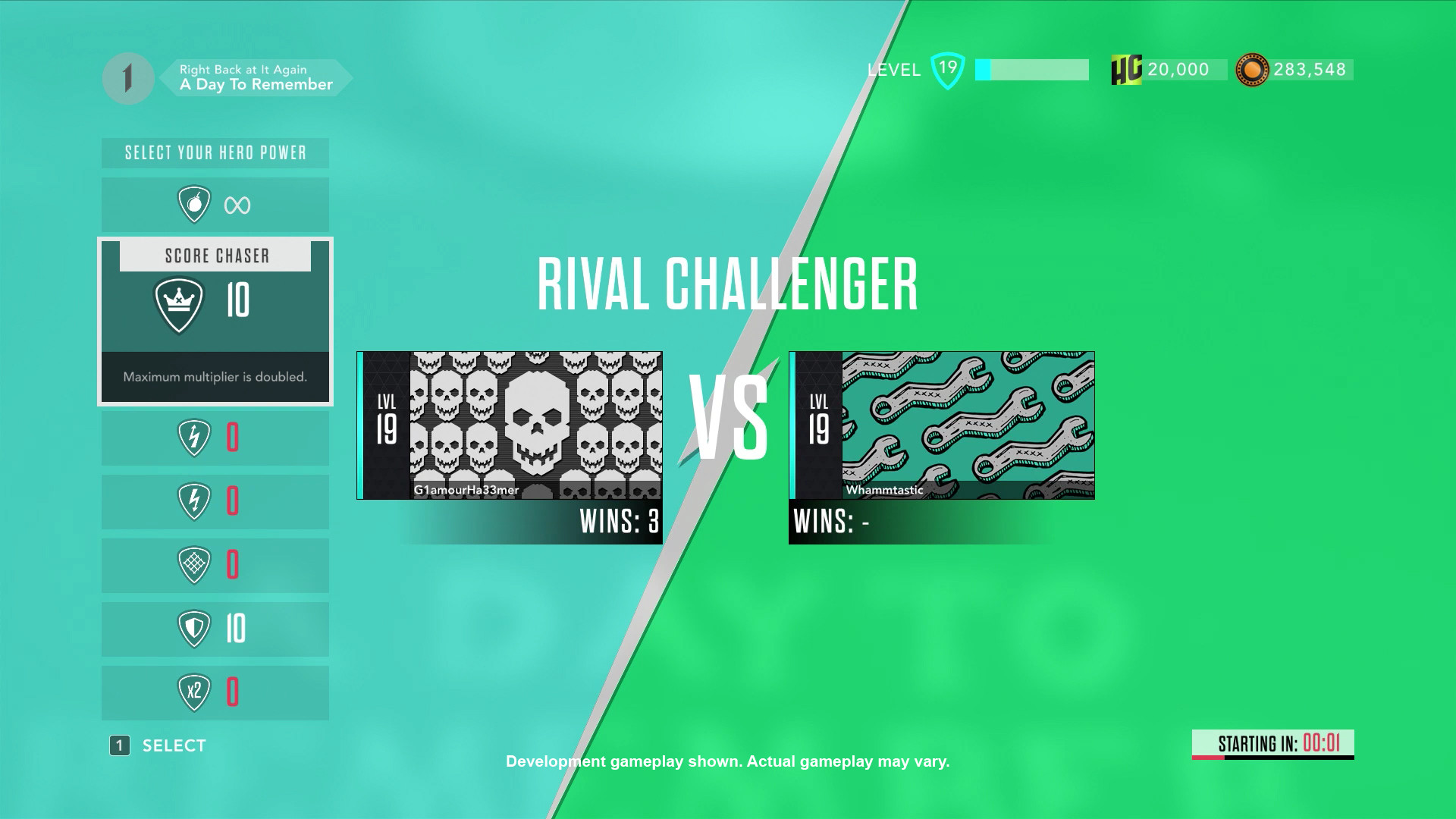 Guitar Hero Live Rivals Mode on PS4
Guitar Hero Live Rivals Mode on PS4
Alt text: Guitar Hero Live’s Rivals mode update on PlayStation 4, showcasing the addition of online competitive elements to the GHTV streaming channels.
Both games demonstrated a commitment to ongoing support and content updates, suggesting that both Guitar Hero Live and Rock Band 4 would continue to evolve and offer new features for PS4 players over time.
Winner – Draw (Both games showed commitment to ongoing updates on PS4)
The Verdict: Choosing Your PS4 Guitar Hero
After a thorough examination across these categories, the ultimate decision between Guitar Hero Live and Rock Band 4 on PS4 hinges on your individual play style and preferences.
If you are primarily a single-player gamer seeking a fresh and innovative guitar experience on PS4, Guitar Hero Live is a compelling choice. Its GHTV mode offers a vast library of streaming songs and a rewarding progression system. The new six-button guitar controller, while requiring an adjustment, provides a more tactile and guitar-like gameplay experience.
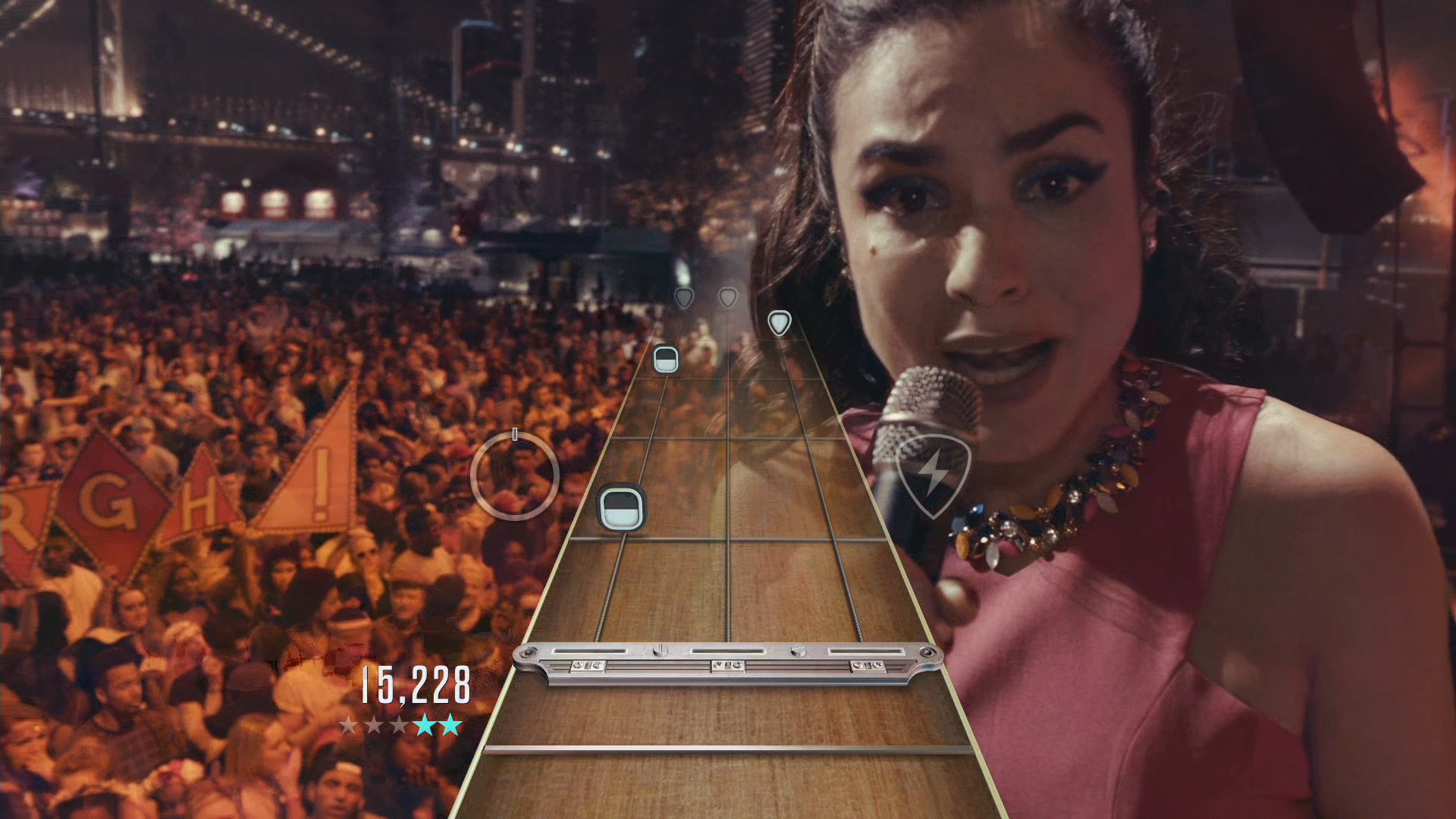 Guitar Hero Live Single Player Focus on PS4
Guitar Hero Live Single Player Focus on PS4
Alt text: Guitar Hero Live’s single-player appeal on PlayStation 4, emphasizing the engaging GHTV mode and innovative guitar gameplay despite the sometimes criticized visuals.
For players who prioritize social gaming, local multiplayer, and the full band experience on PS4, Rock Band 4 is the definitive winner. It delivers the classic Rock Band band gameplay, extensive backwards compatibility for legacy instruments, and a massive, permanently owned DLC library. While its single-player progression is less pronounced, Rock Band 4 excels as a social and multiplayer rhythm game on PS4.
 Rock Band 4 Multiplayer Focus on PS4
Rock Band 4 Multiplayer Focus on PS4
Alt text: Rock Band 4’s multiplayer strengths on PlayStation 4, highlighting the cooperative band experience and social gaming appeal for rhythm game enthusiasts.
Price also plays a role. At launch, Guitar Hero Live with a guitar controller was often more affordable than Rock Band 4 with a guitar bundle. However, Rock Band 4 offered the option to purchase the game software alone for players with existing instruments, potentially making it a more budget-friendly option for those upgrading from previous Rock Band games on PlayStation consoles.
Ultimately, both Guitar Hero Live and Rock Band 4 offered compelling rhythm game experiences on PS4. Your choice depends on whether you prioritize innovative single-player guitar gameplay or social band multiplayer fun. Regardless of your pick, the return of rhythm action games to PlayStation 4 was a victory for music game fans.
